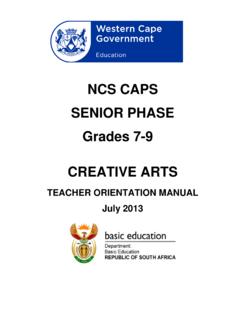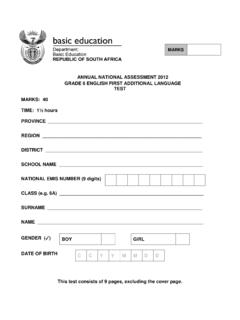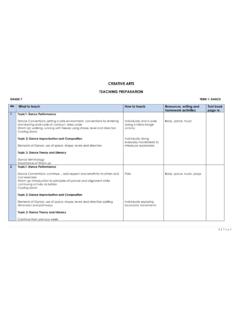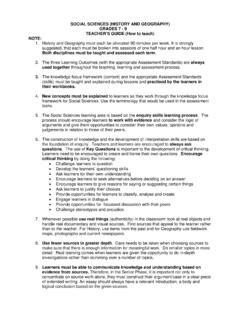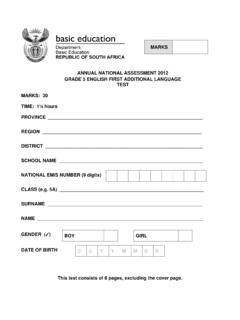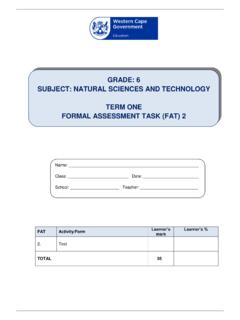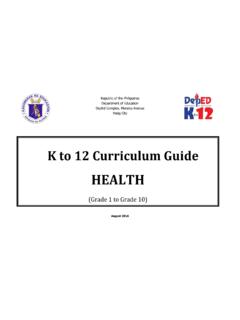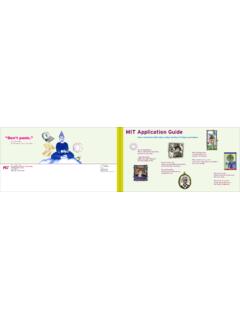Transcription of GRADE: 4 SUBJECT: LIFE SKILLS CREATIVE ARTS TERM ONE ...
1 FAT Activity/Form Learner s mark Learner s % Performing arts : Dance and music Performance TOTAL grade : 4 subject : life SKILLS CREATIVE arts TERM ONE FORMAL ASSESSMENT TASK (FAT) 1 Name: _____ Class: _____ Date: _____ School: _____ teacher : _____ Gr 4: FAT LS CREATIVE arts : Performing arts : Term 1 Page 1 life SKILLS : CREATIVE arts FORMAL ASSESSMENT TASK: PERFORMING arts DANCE AND music grade 4 TERM 1 NOTE TO THE teacher : The Formal Assessment Task has been developed as a step by step guideline to learners. The activities are to be done in class, during the first term. It is important that teachers mediate the various steps of the task with learners to ensure active, CREATIVE and critical participation by all learners.
2 In this activity you will be exposed to the following: Locomotor and non-locomotor movements that will be done on your own and also together in groups. Short rhythm patterns using percussion instruments or body percussion. Rhythmic patterns combining locomotor movements with sound. Movement sentences using props. 1. Choose any of the above animals to create your movement sentence and a short rhythmic pattern. Your movement sentence will show the unique way in which your animal moves. 2. While developing your movement, consider the natural movements and sound effects that are common to the animal your have chosen. 3. On your own, use suitable locomotor and non- locomotor movements to create a movement sentence of 16 counts. Your teacher will guide you to explore a wide variety of movements before you make your selection of appropriate movements.
3 Look at the table below as a reminder of some of the movements. Gr 4: FAT LS CREATIVE arts : Performing arts : Term 1 Page 2 LOCOMOTOR MOVEMENTS NON-LOCOMOTOR MOVEMENTS jump, skip, gallop, crawl, roll, slide, run, run, shuffle, drag, sail, swim, fly, etc. turn, pull, bend, stretch, twist, push, stretch, shrink, grow, shake, rattle, swing, reach up, etc. 4. Now add a short rhythmic pattern, using the note values you have learnt in class and add body percussion or percussion instruments to enhance the movement sentence. 5. Rehearse this movement sentence with the rhythmic pattern. 6. Now choose a prop as an extension of the animal chosen that will be an indication of the animal you chose. 7. Group with the other learners who have chosen the same animal and join the movement sentences together with the rhythmic pattern.
4 You could adapt your dance and rhythmic pattern to accommodate everyone s ideas when you join all the elements. 8. Now it is time to perform your combined movement sentence and short rhythmic pattern to the class! Make sure that you are well-prepared and know exactly what your steps are and how they combine with the rhythmic pattern. Gr 4: FAT LS CREATIVE arts : Performing arts : Term 1 Page 3 The following rubric will be used by your teachers to formally assess your performance: Criteria 10-8 7-6 5-3 2-0 Use of locomotor & non locomotor movements using imagery Confidently performed locomotor & non-locomotor movements with CREATIVE use of imagery Demonstrates understanding of locomotor & non-locomotor movements with use of imagery Performs some locomotor & non-locomotor movements and attempts to use imagery Lacks understanding of locomotor & non-locomotor movements and lacks use of imagery Created short rhythmic patterns using body percussion/ instruments Performed CREATIVE rhythmic patterns with clear understanding of note values Performed a short rhythmic pattern with an understanding of note values Demonstrate short rhythms with some understanding of note values A short rhythmic pattern but lacks understanding of note values
5 Performed movement sentences using props Movement sentence creatively performed using prop with ease and appropriately Movement sentence adequately performed, demonstrated using the prop appropriately Attempted to perform the movement sentence using the prop at times Poor demonstration of movement sentence with very little use of the prop Working individually and in unison Learner confidently works alone and co-operatively in the group Learner works as an individual and forms part of the group Learner shows at times the ability to work alone and in a group Learner struggles to work alone and in a group Subtotals: TOTAL /40 Gr 4: FAT LS CREATIVE arts : Performing arts : Term 1 Page 4 INTEGRATED LEARNING AND ASSESSMENT STRATEGY The learning and assessment processes are integrated.
6 Assessment is continuous and formative as the teacher will observe the progress of the learner and give guidance towards the final performance. The final performance is assessed formally by the teacher by means of a rubric. Assessment Form Assessment Method Assessment Technique Assessment Instrument Informal: Formative Self/peer/ teacher assessment Observation of development of a movement sentence. Class list (just to be ticked off) Informal: Formative Self/peer/ teacher assessment Observation of development of rhythmic pattern. Class list (just to be ticked off) Informal: Formative Self/peer/ teacher assessment Use of a prop in an imaginative way. Class list (just to be ticked off) Formal: Summative teacher Performance of movement sentence combined with a rhythmic pattern.
7 Rubric DISTRIBUTION OF COGNITIVE LEVELS REMEMBER AND UNDERSTAND APPLY AND ANALYSE EVALUATE AND CREATE Dance and music concepts: locomotor and non-locomotor movements, use of props, rhythmic patterns, note values, percussion and melodic instruments. Application of concepts in a performance of a music movement sequence and rhythmic patterns. Continuous critical reflection and application to improve and enhance the performance. Create and perform a movement sequence and rhythmic patterns (According to Revised Bloom s Taxonomy, 1990)


